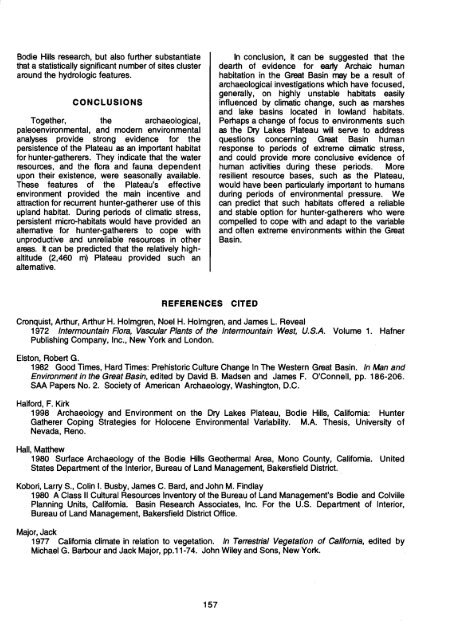archaeology and environment on the dry lakes plateau - Society for ...
archaeology and environment on the dry lakes plateau - Society for ...
archaeology and environment on the dry lakes plateau - Society for ...
You also want an ePaper? Increase the reach of your titles
YUMPU automatically turns print PDFs into web optimized ePapers that Google loves.
Bodie Hills research, but also fur<strong>the</strong>r substantiate<br />
that a statistically significant number of sites cluster<br />
around <strong>the</strong> hydrologic features.<br />
CONCLUSIONS<br />
Toge<strong>the</strong>r, <strong>the</strong> archaeological,<br />
paleo<str<strong>on</strong>g>envir<strong>on</strong>ment</str<strong>on</strong>g>al, <str<strong>on</strong>g>and</str<strong>on</strong>g> modern <str<strong>on</strong>g>envir<strong>on</strong>ment</str<strong>on</strong>g>al<br />
analyses provide str<strong>on</strong>g evidence <strong>for</strong> <strong>the</strong><br />
perSistence of <strong>the</strong> Plateau as an important habitat<br />
<strong>for</strong> hunter-ga<strong>the</strong>rers. They indicate that <strong>the</strong> water<br />
resources, <str<strong>on</strong>g>and</str<strong>on</strong>g> <strong>the</strong> flora <str<strong>on</strong>g>and</str<strong>on</strong>g> fauna dependent<br />
up<strong>on</strong> <strong>the</strong>ir existence, were seas<strong>on</strong>ally available.<br />
These features of <strong>the</strong> Plateau's effective<br />
<str<strong>on</strong>g>envir<strong>on</strong>ment</str<strong>on</strong>g> provided <strong>the</strong> main incentive <str<strong>on</strong>g>and</str<strong>on</strong>g><br />
attracti<strong>on</strong> <strong>for</strong> recurrent hunter-ga<strong>the</strong>rer use of this<br />
upl<str<strong>on</strong>g>and</str<strong>on</strong>g> habitat. During periods of climatic stress,<br />
persistent micro-habitats would have provided an<br />
altemative <strong>for</strong> hunter-ga<strong>the</strong>rers to cope with<br />
unproductive <str<strong>on</strong>g>and</str<strong>on</strong>g> unreliable resources in o<strong>the</strong>r<br />
areas. It can be predicted that <strong>the</strong> relatively highaltitude<br />
(2,460 m) Plateau provided such an<br />
altemative.<br />
In c<strong>on</strong>clusi<strong>on</strong>, it can be suggested that <strong>the</strong><br />
dearth of evidence <strong>for</strong> early Archaic human<br />
habitati<strong>on</strong> in <strong>the</strong> Great Basin may be a result of<br />
archaeological investigati<strong>on</strong>s which have focused,<br />
generally, <strong>on</strong> highly unstable habitats easily<br />
influenced by climatic change, such as marshes<br />
<str<strong>on</strong>g>and</str<strong>on</strong>g> lake basins located in lowl<str<strong>on</strong>g>and</str<strong>on</strong>g> habitats.<br />
Perhaps a change of focus to <str<strong>on</strong>g>envir<strong>on</strong>ment</str<strong>on</strong>g>s such<br />
as <strong>the</strong> Dry Lakes Plateau will serve to address<br />
questi<strong>on</strong>s c<strong>on</strong>cerning Great Basin human<br />
resp<strong>on</strong>se to periods of extreme dimatic stress,<br />
<str<strong>on</strong>g>and</str<strong>on</strong>g> could provide more c<strong>on</strong>clusive evidence of<br />
human activities during <strong>the</strong>se periods. More<br />
resilient resource bases, such as <strong>the</strong> Plateau,<br />
would have been particularly important to humans<br />
during periods of <str<strong>on</strong>g>envir<strong>on</strong>ment</str<strong>on</strong>g>al pressure. We<br />
can predict that such habitats offered a reliable<br />
<str<strong>on</strong>g>and</str<strong>on</strong>g> stable opti<strong>on</strong> <strong>for</strong> hunter-ga<strong>the</strong>rers who were<br />
compelled to cope with <str<strong>on</strong>g>and</str<strong>on</strong>g> adapt to <strong>the</strong> variable<br />
<str<strong>on</strong>g>and</str<strong>on</strong>g> often extreme· <str<strong>on</strong>g>envir<strong>on</strong>ment</str<strong>on</strong>g>s within <strong>the</strong> Great<br />
Basin.<br />
REFERENCES CITED<br />
Cr<strong>on</strong>qUist, Arthur, Arthur H. Holmgren, Noel H. Holmgren, <str<strong>on</strong>g>and</str<strong>on</strong>g> James L. Reveal<br />
1972 Intermountain Flora, Vascular Plants of <strong>the</strong> Intermountain West, U.S.A. Volume 1. Hafner<br />
Publishing Company, Inc., New York <str<strong>on</strong>g>and</str<strong>on</strong>g> L<strong>on</strong>d<strong>on</strong>.<br />
Elst<strong>on</strong>, Robert G.<br />
1982 Good Times, Hard Times: Prehistoric Culture Change In The Western Great Basin. In Man <str<strong>on</strong>g>and</str<strong>on</strong>g><br />
Envir<strong>on</strong>ment in <strong>the</strong> Great Basin, edited by David B. Madsen <str<strong>on</strong>g>and</str<strong>on</strong>g> James F. O'C<strong>on</strong>nell, pp. 186-206.<br />
SM Papers No.2. <strong>Society</strong> of American Archaeology, Washingt<strong>on</strong>, D.C.<br />
Hal<strong>for</strong>d, F. Kirk<br />
1998 Archaeology <str<strong>on</strong>g>and</str<strong>on</strong>g> Envir<strong>on</strong>ment <strong>on</strong> <strong>the</strong> Dry Lakes Plateau, Bodie Hills, Califomia: Hunter<br />
Ga<strong>the</strong>rer Coping Strategies <strong>for</strong> Holocene Envir<strong>on</strong>mental Variability. M.A. Thesis, University of<br />
Nevada, Reno.<br />
Hall, Mat<strong>the</strong>w<br />
1980 Surface Archaeology of <strong>the</strong> Bodie Hills Geo<strong>the</strong>rmal Area, M<strong>on</strong>o County, Califomia. United<br />
States Department of <strong>the</strong> Interior, Bureau of L<str<strong>on</strong>g>and</str<strong>on</strong>g> Management, Bakersfield District.<br />
Kobori, Larry S., Colin I. Busby, James C. Bard, <str<strong>on</strong>g>and</str<strong>on</strong>g> John M. Findlay<br />
1980 A Class II Cultural Resources Inventory of <strong>the</strong> Bureau of L<str<strong>on</strong>g>and</str<strong>on</strong>g> Management's Bodie <str<strong>on</strong>g>and</str<strong>on</strong>g> Colville<br />
Planning Units, Califomia. Basin Research Associates, Inc. For <strong>the</strong> U.S. Department of Interior,<br />
Bureau of L<str<strong>on</strong>g>and</str<strong>on</strong>g> Management, Bakersfield District Office.<br />
Major, Jack<br />
1977 Califomia climate in relati<strong>on</strong> to vegetati<strong>on</strong>. In Terrestrial Vegetati<strong>on</strong> of cali<strong>for</strong>nia, edited by<br />
Michael G. Barbour <str<strong>on</strong>g>and</str<strong>on</strong>g> Jack Major, pp.11-74. John Wiley <str<strong>on</strong>g>and</str<strong>on</strong>g> S<strong>on</strong>s, New York.<br />
157
















